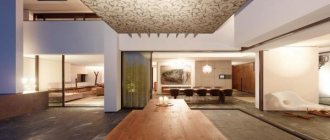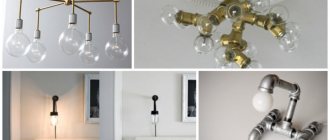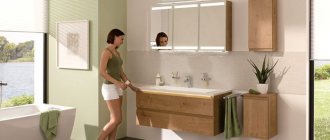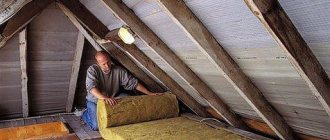When bringing interesting ceiling lighting ideas to life, it is worth taking into account some basic recommendations regarding the location, design and design features of individual types of lamps. The right lighting can truly transform a room.
Consider the following points:
- light distribution should occur evenly over the surface;
- lamps must have a certain power and provide the necessary illumination intensity;
- It is best to use the most economical, at the same time having a long service life, lamps (optimally LED);
- wires must be hidden;
- when using a hidden type of lighting, hide the lamp housings in a special cornice;
- to create a soft, flooding light, you need to point the lampshade upward;
- The design of the lamps should be in harmony with the furniture and the overall style of the room.
Main light sources
The classic option is to use chandeliers to illuminate the room. In this case, you need to pay attention first of all to the weight of the product. Some ceilings (for example, plasterboard) may not cope with heavy loads.
Chandelier lighting provides a fairly intense and diffuse flow. In this case, one chandelier may be completely enough to illuminate the room. Its advantage is that, if desired, you can illuminate both a two-level and a sloping ceiling (using a hanging product on a chain).
Spot lighting on the ceiling is a modern option. There are external and built-in lamps. The former better distribute light over the entire surface.
Such lamps have a huge number of advantages; their ease of installation and visual appeal incline one to choose this type of lighting. The downside is that some of these products can damage the ceiling when heated; such problems can arise most often with stretch ceilings.
Directional lamps are convenient for highlighting specific areas; they have a focused luminous flux.
With their help, it is possible to visually change and expand the space. In addition, directional light is good to use in the kitchen in the work area.
Installation of so-called hidden lighting requires the use of LED or neon strips. They can be used in any room except the bathroom - they do not tolerate high humidity conditions.
Ceiling lighting ideas for different rooms
Today there are many ways to decorate a ceiling using light. When choosing, you should take into account the purpose of the room and what characteristics the lighting fixtures have.
Corridor
A few recommendations for corridor lighting:
- For low ceilings, it is recommended to place lamps with a given direction of light towards the walls and upwards in order to increase the volume of the room.
- If the ceiling level is below average, then the effects of original lighting are achieved using halogen devices.
- To expand the space, lamps should be built in and mounted so that the light falls on the walls.
- If the ceiling level is high, then you can install several hanging lighting fixtures, so the light will fall on the floor.
Related article: Lighting for a children's room: tips on organization
Kitchen
The main or general lighting required for this room is used, additional - local in the form of spotlights, wall sconces. The first type is usually used to illuminate the entire area, and the second in the place of preparation or eating.
Bedroom
Before installing lighting fixtures, you need to make sure where the bed will be located; the routing of the wire depends on this. It is recommended to place the main lighting in the center of the room; you can use a regular chandelier, and hang a night lamp with a halogen lamp on the wall near the bed.
Living room
The main lighting element can be a chandelier located in the center of the room, but it is important to take into account the parameters of the area and the height of the ceiling. If the room is large, then an oversized chandelier will look original. If the living room is small, then the ceiling can be decorated with built-in lamps to visually expand the space.
Bathroom
The ideal solution would be matte or transparent shades. If the ceiling level is very high, then you can hang a chandelier, and if it is low, then it is enough to fix the lamps to the walls. It is worth noting that the selected materials made of colored glass will not be the best option, since the flow of light will be distorted.
Balcony
There is little space in this area, so you can use:
- small table lamp;
- ceiling light source;
- wall placement of sconces.
Usually, for lighting on a balcony or loggia, the choice is made in favor of devices designed for the street.
Corridor
Most often, this is a room with an awkward layout - narrow and long, or so small that there is nowhere to put a closet.
This can be visually changed with the help of light: installing spotlights along the corridor, the beams of light from which are directed downwards, will visually make the room shorter. If it is necessary to expand the space, the light should go up.
Spot lighting in different rooms
Spot lighting is used in absolutely any room, not only in the living room, bedroom, but also in the hallway, bathroom, toilet and corridor. This is the optimal solution if the apartment area is small. But here it is worth considering that spotlights must be installed in a suspended or suspended ceiling structure, and it is not suitable for every room.
Related article: Lighting for indoor flowers: selection, features and types of lamps
Before installing such lamps, it is necessary to make markings on the film or sheet of plasterboard, taking into account:
- ceiling area;
- purpose of the room;
- general design;
- number of available chandeliers and sconces.
Hallway
The light should be saturated with bright tones, but not to such an extent that the light hurts the eye. The best option is to create diffused light. Spotlights can be arranged in numerous bunches, and a chandelier can be placed in the center.
Kitchen
For any owner, light in the kitchen is a must. It is necessary to maintain the distance between lighting devices, and also calculate their power. When choosing an additional light source, the number of main lamps must be reduced.
Living room
One of the solutions when decorating a living room is the use of combined lighting. Spotlights are evenly located relative to the main light source or along the perimeter; here you need to take into account the possibility of adjusting the power.
Bedroom
To prevent the light from being noticeable, it is recommended to place spotlights on the steps of the ceiling or along its perimeter. It is better to set the number of lamps less than what was calculated. To adjust the lighting, it is recommended to use a dimmer.
Children's
Lighting is created by point light sources above the children’s workplace, for example, where they draw or do other creative work. In addition, using spotlights of different powers and light, you can create an imitation of a fairy tale for children.
Bathroom
To illuminate this room, no more than two spotlights are sufficient, since the area is usually no more than 5 m2. Everything is determined by calculation. Under any circumstances, it is worth considering that the sealed design of lighting devices is important and the ideal solution would be to use halogen lamps.
Options for suspended ceilings
This type of ceiling is equipped with several types of lamps. The only distinguishing feature is the depth of installation of live parts. The use of mortise lighting devices is most important, and a ring is attached around the lamps to prevent the film from tearing.
Above ceiling level
Lighting fixtures installed above the ceiling create the effect of glowing from within. It looks great, but it has a number of disadvantages:
- the area is not fully illuminated;
- the lamps may become very hot;
- the need to use LED lamps.
At ceiling level
Recessed spotlights are installed directly into the ceiling structure itself. The lighting of the space is carried out depending on the idea. But the light dispersion coefficient is quite high. Lamps with a power exceeding 35 W cannot be installed, and a transformer must be installed.
Below level and overhead
The main distinguishing characteristics of such lighting are a large percentage of light dispersion. This category includes spotlights that are also built into a suspended or suspended structure, but the lighting element extends beyond the ceiling. They may have glass shades and hanging decorative elements.
For the installation of surface-mounted lamps, a special base is used, which allows the use of lamps of different power ratings.
Other options
Using fiber optic spotlights, you can create an imitation of the starry sky. Two-level stretch ceilings with additional lighting are quite original in their solution. It is worth considering that when choosing minion type lamps, one element is installed per 2 m2.











